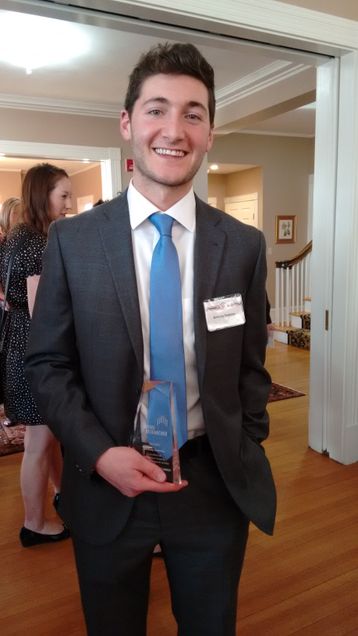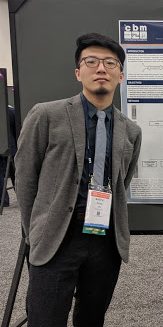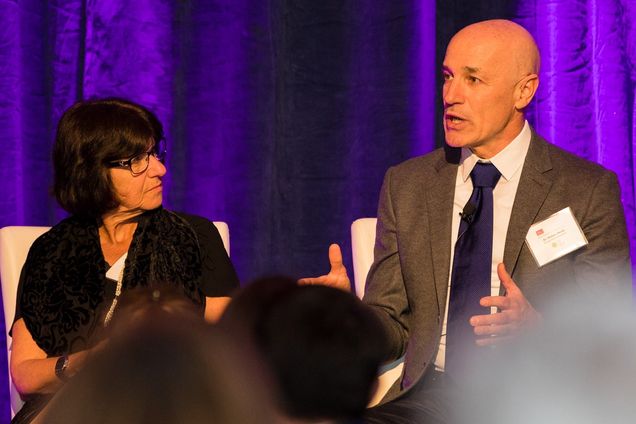(Boston)--Researchers from Boston University Schools of Medicine (BUSM) and Public Health have developed and evaluated a fast, accurate and cost-effective approach to assessing the carcinogenicity of chemicals--that is, whether exposure to a chemical increases a person's long-term cancer risk. As a result, they have generated one of the largest toxicogenomics datasets to date, and have made the data and results publicly accessible through a web portal at carcinogenome.org.
Trainee, Visitor and Volunteer Onboarding
Denise Fine recognized with 2019 BUMC Research Professional Network All Star Award
September 16th, 2019
The 2019 BUMC Research Professional Network All Star Award will be awarded to Denise Fine, Clinical Research Coordinator. The All Star Award recognizes a clinical research professional who, during their career at BMC/BU Medical Campus, has made consistently superior contributions of outstanding significance to the field of clinical research at the institution. This person will have demonstrated tremendous experience in the clinical, regulatory, and/or financial aspects of the clinical research profession, and has contributed to training the next generation of clinical research professionals. This award recognizes that the scope of clinical research is diverse and encourages the input of a wide variety of individuals that the awardee has worked with.
Moorman-Simon Fellowship 2019-2020
Moorman-Simon Fellowships in Computational Biomedicine
The Moorman-Simon Fellowship in Computational Biomedicine was established in the summer of 2019 to provide fellowships, one year in duration to current Ph.D. students in Computational Biomedicine who are working in the field of cancer research. This fund was established through a generous gift by Trustee Ruth A. Moorman (CAS’88, Wheelock’89,’09, Parent BUA’15) and Sheldon N. Simon.
Recipients:
AY 2019-2020

Project Title: Intercepting head and neck cancer using functional genomics approaches
Trainee Name: Anthony Federico
Faculty Mentor: Stefano Monti, PhD
Graduate Program: Bioinformatics PhD Program, Boston University
Expected Graduation: May 2022

Project Title: Identification of microRNA-mRNA regulatory interactions associated with bronchial premalignant lesion histologic severity and progression
Trainee Name: Boting Ning
Faculty Mentor(s): Jennifer Beane, Marc Lenburg and Avrum Spira
Graduate Program: Bioinformatics
Expected Graduation Month/Year: 2022
2019-2020 Dahod Awards Announced
July 8, 2019
Source: Office of the Dean, Boston University School of Medicine
Congratulations to Joshua D. Campbell, PhD, and William Evan Johnson, PhD, recipients of the 2019-2020 Dahod Pilot Grant Program Fund. In August 2008, Shamim Dahod (CGS’76, CAS’78, MED’87) and her husband Ashraf gave $10.5M to BUSM to establish the Shamim and Ashraf Dahod Breast Cancer Research Center, as well as these programs and endowments. Dr. Campbell has received a Dahod Pilot Grant for his work understanding basic interactions between tumor cells, the immune system and other cells within the microenvironment. Dr. Johnson has received a Dahod Pilot Grant for his work in triple negative breast cancer (TNBC).
Read more about this award and its recipients here.
New Method for Evaluating Cancer Risk of Chemicals is Quick, Precise, Inexpensive

Source: EurekAlert!
New Publication: Scruff: an R/Bioconductor package for preprocessing single-cell RNA-sequencing data
Thursday, May 2, 2019
Source: BMC Bioinformatics
Background
Single-cell RNA sequencing (scRNA-seq) enables the high-throughput quantification of transcriptional profiles in single cells. In contrast to bulk RNA-seq, additional preprocessing steps such as cell barcode identification or unique molecular identifier (UMI) deconvolution are necessary for preprocessing of data from single cell protocols. R packages that can easily preprocess data and rapidly visualize quality metrics and read alignments for individual cells across multiple samples or runs are still lacking.
Results
Here we present scruff, an R/Bioconductor package that preprocesses data generated from the CEL-Seq or CEL-Seq2 protocols and reports comprehensive data quality metrics and visualizations. scruff rapidly demultiplexes, aligns, and counts the reads mapped to genome features with deduplication of unique molecular identifier (UMI) tags. scruff also provides novel and extensive functions to visualize both pre- and post-alignment data quality metrics for cells from multiple experiments. Detailed read alignments with corresponding UMI information can be visualized at specific genome coordinates to display differences in isoform usage. The package also supports the visualization of quality metrics for sequence alignment files for multiple experiments generated by Cell Ranger from 10X Genomics. scruff is available as a free and open-source R/Bioconductor package.
Conclusions
scruff streamlines the preprocessing of scRNA-seq data in a few simple R commands. It performs data demultiplexing, alignment, counting, quality report and visualization systematically and comprehensively, ensuring reproducible and reliable analysis of scRNA-seq data.
New Publication: Tobacco-Related Alterations in Airway Gene Expression are Rapidly Reversed Within Weeks Following Smoking-Cessation
Kahkeshan Hijazi, Bozena Malyszko, Katrina Steiling, Xiaohui Xiao, Gang Liu, Yuriy O. Alekseyev, Yves-Martine Dumas, Louise Hertsgaard, Joni Jensen, Dorothy Hatsukami, Daniel R. Brooks, George O’Connor, Jennifer Beane, Marc E. Lenburg & Avrum Spira
Monday, May 6, 2019
Source: Nature
The physiologic response to tobacco smoke can be measured by gene-expression profiling of the airway epithelium. Temporal resolution of kinetics of gene-expression alterations upon smoking-cessation might delineate distinct biological processes that are activated during recovery from tobacco smoke exposure. Using whole genome gene-expression profiling of individuals initiating a smoking-cessation attempt, we sought to characterize the kinetics of gene-expression alterations in response to short-term smoking-cessation in the nasal epithelium. RNA was extracted from the nasal epithelial of active smokers at baseline and at 4, 8, 16, and 24-weeks after smoking-cessation and put onto Gene ST arrays. Gene-expression levels of 119 genes were associated with smoking-cessation (FDR < 0.05, FC ≥1.7) with a majority of the changes occurring by 8-weeks and a subset changing by 4-weeks. Genes down-regulated by 4- and 8-weeks post-smoking-cessation were involved in xenobiotic metabolism and anti-apoptotic functions respectively. These genes were enriched among genes previously found to be induced in smokers and following short-term in vitro exposure of airway epithelial cells to cigarette smoke (FDR < 0.05). Our findings suggest that the nasal epithelium can serve as a minimally-invasive tool to measure the reversible impact of smoking and broadly, may serve to assess the physiological impact of changes in smoking behavior.
Inside the Biotech Company Hoping to Solve Medical Mysteries
What If We Could Stop Lung Cancer Before It Starts?
Tuesday, April 23, 2019
Source: BU Today
Genomic differences related to the immune system may play a key role in the early development of lung cancer. That finding, published April 23, 2019, in Nature Communications, reveals potential for developing new therapeutics that could boost immune activity to prevent or halt progression of the disease, says Avrum Spira (ENG’02), the study’s senior author. He says that the newly identified genomic differences can be detected in normal airway tissue before any precancerous activity begins, which could potentially help physicians screen and monitor smokers who are at the highest risk of lung cancer.
Spira is the director of the Johnson & Johnson Innovation Lung Cancer Center at Boston University on the Medical Campus and the global head of the Johnson & Johnson Lung Cancer Initiative. He has been working for several years with collaborators on a Precancer Genomic Atlas (PCGA) project to identify early cellular and molecular changes that lead to invasive lung cancer. The new paper is the first one produced from the translational research alliance, launched in June 2018, between BU and Johnson & Johnson Innovation LLC (JJI).
“Lung cancer is the leading cause of cancer deaths worldwide, because the disease is typically diagnosed in its later stages,” says William N. Hait, global head of Johnson & Johnson External Innovation, Johnson & Johnson Innovation, LLC, in a press release about the findings. More people die of lung cancer than from colon, breast, and prostate cancers combined—in the United States alone, lung cancer kills about 143,000 people each year. Worldwide, the number of people with the disease remains high and is growing in certain regions, and among women. In China, for example, 730,000 new cases of lung cancer were reported in 2015 and the number is expected to rise.
“The lung undergoes many changes prior to the development of [full-blown] lung cancer, so we have an opportunity to leverage those changes to both identify people at high risk for lung cancer and to intercept the disease process,” says Jennifer Beane (ENG’07), the lead and corresponding author of the Nature Communications study, and a Boston University School of Medicine assistant professor of computational medicine.
The new findings have identified four different genomic subtypes among current and former cigarette smokers who develop precancerous lesions. In people with the most problematic subtype, their immune response is impaired, says Spira, a BU School of Medicine professor of medicine, pathology, and bioinformatics and the Alexander Graham Bell Professor in Health Care Entrepreneurship.
“That’s one of the things that tumors do—prevent the immune system from attacking them. We think precancer cells might do that as well,” Spira says. “This opens up the opportunity to come in and find a way to train the immune system to eradicate those lesions.”
Any drug that could arrest or prevent lung cancer from developing in smokers would be the first of its kind. “There is nothing [for lung cancer] like there is aspirin for colorectal cancer or statins for cardiovascular disease,” he says.
In the study, Beane, Spira, and other scientists at MED, the University of California, Los Angeles, the Roswell Park Comprehensive Cancer Center, in Buffalo, N.Y., and Janssen Research & Development used bronchoscopes to take biopsies of precancerous lung lesions in current and former smokers, following the study participants over several years to see if their lesions progressed toward lung cancer or not. They identified biological changes within the lesions that indicated a higher risk of progression and showed that those lesions had reduced activity of genes related to certain kinds of immune cells.
“This is an example where academia does the very basic discovery science—finding patients that have these early precancer lesions, biopsying them, and doing very deep molecular profiling, and the bioinformatics analysis,” says Spira. Then, from those academic findings, “industry can look at the data and figure out how to develop a therapeutic that will leverage that insight, that would reactivate the immune system to intercept the precancerous lesions from progressing to invasive lung cancer.”
In addition to its other findings, the new study suggests that changes in aggressive precancerous lesions could be detected by “brushing,” using a flexible brush to gather cells from the airway through the catheter of a bronchoscope, which is a much less invasive procedure than a traditional lung or airway biopsy.
“Normal-appearing cells in the airway can still show you the genomic signature,” says Beane. “It’s early days, but maybe one day [we] could develop a simpler test to find someone who is incubating a lung cancer and [we’d] know who to treat to intercept lung cancer.”
The PCGA was developed by Janssen Research & Development, LLC, one of the Janssen Pharmaceutical Companies of Johnson & Johnson, and BU. It has received additional funding from Stand Up To Cancer-LUNGevity-American Lung Association Lung Cancer Interception Dream Team, the National Cancer Institute, and the new Translational Research Alliance between BU and the Lung Cancer Initiative at J&J.
This study was supported in part by the National Cancer Institute, National Institutes of Health; the National Heart, Lung, and Blood Institute, National Institutes of Health; Stand Up To Cancer, LUNGevity, American Lung Association Lung Force; and Janssen Research & Development, LLC.
Researchers Develop Combined Data Model to Better Evaluate for Mild Cognitive Impairment
Thursday, October 4, 2018
Source: BUSM
Cognitive decline is one of the most concerning behavioral symptoms associated with Alzheimer’s disease (AD). The ability to efficiently distinguish individuals with mild cognitive impairment (MCI) from individuals who have normal cognition (NC) is crucial for early detection of AD.
In the past, different tests have been used to evaluate MCI. The Mini-Mental State Examination (MMSE) is a commonly used screening tool for dementia. Additionally, the Wechsler Memory Scale Logical memory (LM) test is a neuropsychological test that assesses verbal memory and is considered sensitive for AD. Neuroimaging, such as magnetic resonance imaging (MRI) provide biologic evidence that cognitive decline is neurodegenerative.
Educating the Next Generation of Medical Professionals with Machine Learning is Essential
Thursday, September 27, 2018
Source: BUSM
“The general public has become quite aware of AI and the impact it can have on health care outcomes such as providing clinicians with improved diagnostics. However, if medical education does not begin to teach medical students about AI and how to apply it into patient care then the advancement of technology will be limited in use and its impact on patient care,” explained corresponding author Vijaya B. Kolachalama, PhD, assistant professor of medicine at BUSM.
Using a PubMed search with ‘machine learning’ as the medical subject heading term, the researchers found that the number of papers published in the area of ML has increased since the beginning of this decade. In contrast, the number of publications related to undergraduate and graduate medical education have remained relatively unchanged since 2010.
